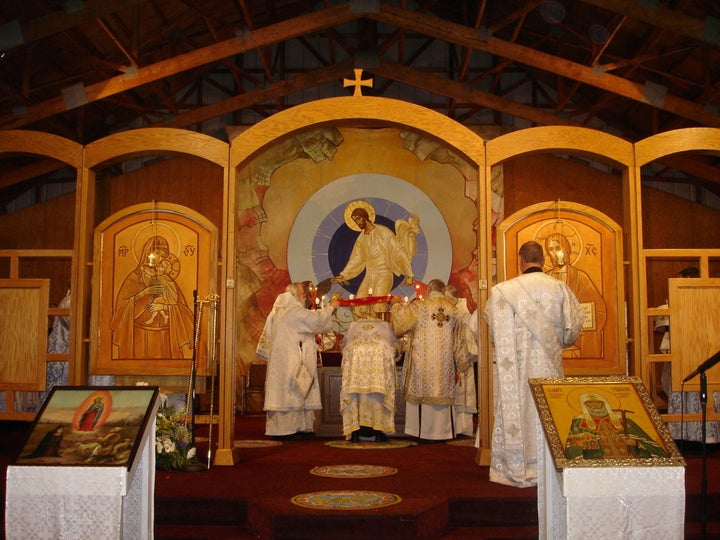
It's a little bit after one in the afternoon and Father Sergius (Bowyer), the Abbott of St. Tikhon of Zadonsk monastery in South Canaan, Pa., is chatting with a handful of monks. The small group is standing in the garden-grotto area just outside the monastery dinning room. The mood is upbeat because in a couple days a miraculous icon from the 13th century, The Wonderworking Kursk Root Icon of Our Lady of the Sign, will be visiting St. Tikhon's.
On this afternoon, which happens to be the last of my three day visit to St. Tikhon's, I mention to the monks that since I haven't read a newspaper in three days for all I know New York City could have disappeared in a cloud of Armageddon smoke.
"If that were to happen," Fr. Sergius says with a smile, "they'd all be coming up here for refuge."
"They'd be coming here by the hundreds for food and shelter and the safety of the mountains," another monk ventured. "But we would require them to go to Divine Liturgy first."
"No we wouldn't," Fr. Sergius answered quickly. "You do not force people to attend Divine Liturgy. We would take them in -- regardless."
"Taking people in" has traditionally been the mark of a monastery's commitment to hospitality. Generally, visitors to monasteries, both Orthodox and Catholic, are advised to stay not more than three days and to donate whatever they can at the end of their stay. While some monasteries suggest a specific donation, St. Tikhon's leaves the question open.
Visitors are also encouraged to follow as much of the routine of the monks as they can, and this includes attendance at the daily Divine Liturgy.
The Divine Liturgy is the Orthodox "version" of the Catholic Mass, albeit with none of the changes, novelties or controversies surrounding that liturgy since the time of the Second Vatican Council, which opened the door to many liturgical abuses. At St. Tikhon's and elsewhere in the Orthodox world, there are no updated liturgies that attempt to be "modern." You won't, for instance, see lay ministers in high heels distributing communion, or hear neo-Catholic hymns like "On Eagles Wings."
In the monastery church, prayer and Liturgy begin at 6 a.m. Congregants mostly stand throughout the three-hour service. Chairs are arranged alongside the church for the old and infirm, but anyone can take a seat if standing becomes unbearable. Prior to my visit I feared that the constant standing would be less than tolerable, however I soon found that the rhythm of the chanting and prayers produced a transcendent state that erased discomfort. After a while, I almost forgot that I had legs. The sensation was a little bit like floating.
St. Tikhon's is located high in the Pocono Mountains on 300 acres of land some 30 minutes (by car) outside Scranton, Pa. The monastery was founded in 1905 by Patriarch (Saint) Tikhon under the auspices of the Russian Orthodox Church. Years later the word Russian was dropped for the more inclusive Orthodox Church of America, or OCA. The monastery houses 14 monks from various parts of the country. Fr. Sergius, a former Roman Catholic who once served at the altar at his boyhood Novus Ordo parish, converted to Orthodoxy and soon after became an Orthodox priest. His conversion happened, he says, because he felt that Orthodoxy offered him a life "more fully in Christ."
"My family is still Catholic," Fr. Sergius told me in his office in the monastery bookstore. "Ultimately the important thing is to keep Christ as the center of our lives."
This isn't to say that Fr. Sergius doesn't like a friendly debate. While discussing his journey from Rome to Orthodoxy, he mentioned that not far from his childhood parish church was an Eastern Rite Catholic church. This led to my comment that the two Eastern Liturgies, Catholic and Orthodox, were Xerox copies of one another.
"Not really," Fr. Sergius said, "If you were to place them side by side, have them going at once, I'd be able to tell you very quickly which one was Orthodox."
While many Eastern Catholics have criticized the forced Latinization of their rites in the past by the Latin Roman rite, in 2011 it is the Eastern Catholics themselves who tend to adopt western ways, despite Rome's insistence that they remain thoroughly Eastern. (Behind the monastery church is the tomb of Saint Alexis Toth, a former Eastern Catholic priest who converted to Orthodoxy after experiencing significant prejudice from United States Latin rite clergy who had no tolerance for Eastern Rite practices. The Catholic Church paid a hefty price for its mistreatment of Toth because thousands of Eastern Catholics followed Toth into the Orthodox Church.)
The historic debate having to do with which Church is the true Church of the apostles, has been raging since the official split of East and West in 1054 A.D. Some Orthodox clergy believe it was a mutual parting of the ways, like a divorce, but this does not stop "experts" on both sides from accusations of schism or heresy. Fr. Sergius emphasized that the Orthodox Church hasn't changed at all in 2,000 years whereas the Latin Church added the Filoque clause to the Nicene Creed after being forced to do so by the emperor Charlemagne -- a secular intrusion into the sacred realm. From that moment on, Fr. Sergius pointed out, the Latin Church continued to make more and more changes, right up to and including the Second Vatican Council.
Most visitors to St. Tikhon's, unless traveling by car, must take a bus to Scranton (where there is no Amtrak service) and then arrange to be met by a monk who will drive them the rest of the way to the monastery. My monk driver met me at the station in his black cassock, beard and black hat.
The monk showed me to the newly refurbished men's guest house where the small, smart library included books by Fr. Seraphim Rose, Orthodoxy's version of Catholicism's Thomas Merton, as Rose (or Eugene Rose), was a former San Francisco-based atheist and Marxist who hung out with the Beats and knew Alan Watts (and even had a male lover) before converting to Orthodoxy, and becoming a monk. (In his most famous book, "Orthodoxy and the Religion of the Future," Rose criticizes Merton for attempting to merge Catholicism with Buddhism and Zen and even suggests that perhaps the Catholic monk's accidental death in the Near East in 1969 came at the right time.)
Meals at St. Tikhon's (except for breakfast) are mostly silent affairs as monks and visitors listen to readings from the lives of the saints or the writings of the Church Fathers.
While there are many orders of Catholic monks who dress in a variety of habits, in the Orthodox world all monks dress alike: black cassock and belt with a small raised black hat. Orthodox monks do not shave or cut their hair, so depending on the monk long hair can be bunched up pony tail-style or arranged in a "bun" of some sort to get it off the neck. The visual effects of this for the first time visitor can be startling. One gray haired monk's rustic demeanor and long pony tail kept reminding me of the Hell's Angels, whereas a young novice's appearance -- with his long hair arranged in a fan-like web at the nape of his neck -- seemed to be "modeled" after an angelic figure in a Byzantine icon.
The majority of the monks at St. Tikhon's are converts from evangelical Protestantism.
Many of the converts are in their 20s, young men from Kansas, Ohio or Los Angeles, where they found their way -- "through the grace of God," as Fr. Sergius likes to say -- to this esoteric mountain top.
Although talking with the monks didn't come easily for me, the process was helped considerably when Fr. Sergius announced to the group that I was visiting the monastery "to do a story." Before the announcement, I felt as if I was breaking a rule whenever I'd ask a brother a question or request a photograph. While a few of the younger monks tended to shyly defer to "the Abbott," the older monks proved to be more forthcoming.
"I spent a lot of years searching," one of the monk cooks told me. "I was an atheist, I shopped around. I'd go to Catholic and Anglican churches. Once I went into this really fancy high Anglican Church, prayed, but when communion time came around they started passing out little cups of grape juice. No way can I do this," I thought. The monk concluded by saying that Orthodoxy gave him the spiritual fullness that he had been searching for.
On the monastery grounds is St. Tikhon's seminary, opened in 1937, which trains hundreds of married and unmarried men for the priesthood. Construction on new buildings was going strong during my visit. Students from the seminary sometimes work at the monastery and live with the monks "for the experience." Not far off is one of St. Tikhon's two lakes, hand dug by the monks and stocked with fish that invariably wind in the monastery dining room.
One seminarian, a convert from evangelical Protestantism, sat near me during many noonday meals. Since Orthodox priests (but not monks) can marry, this priest-to-be made several references to "finding a wife" when the time was right.
For a born-and-bred Roman Catholic (who later converted to Orthodoxy), I had to remind myself that celibacy among priests (not monks) was also a change made by the Western church, a deviation from the ancient Church.
